Discovery the Fermano Territory
Discovery the Fermano Territory

MUNICIPALITY OF FERMO
CIVIC ART GALLERY
_.jpg) The Civic Art Gallery is on the second floor of Palazzo dei Priori, the most ancient palace of the city, built in 1296 over the ancient noble palace and the church of St. Martino and finally completed in 1525. Located in Piazza del Popolo, the heart of the town, Palazzo dei Priori presents a fan shape, given to it in the middle of the seventeenth cenuty. The central double staircase ends with a loggia where above it there is the statue of Sisto V Peretti, First bishop of Fermo. Originally the Gallery was established in 1890 in different rooms of the Municipal Library and the current location was born only in 1986.
The Civic Art Gallery is on the second floor of Palazzo dei Priori, the most ancient palace of the city, built in 1296 over the ancient noble palace and the church of St. Martino and finally completed in 1525. Located in Piazza del Popolo, the heart of the town, Palazzo dei Priori presents a fan shape, given to it in the middle of the seventeenth cenuty. The central double staircase ends with a loggia where above it there is the statue of Sisto V Peretti, First bishop of Fermo. Originally the Gallery was established in 1890 in different rooms of the Municipal Library and the current location was born only in 1986.
Gallery's rooms, five to be exacts, preserve a lot of paintings, artifacts of stone, costumes, porcelains of inestimable value. In particular, the room of 1600 or Rubens' room hold the famous “The Adoration of the shepherds” of Peter Paul Rubens (1608), that the legend says it was sent, rolled up and put on the back of a donkey by the same Rubens.
From the gallery, it's possible to enter to the room of the world globe, deeply wanted by the Cardinal Decio Azzolino Junior, Decio Azzolino junior Cardinal, that preserves the original nucleos of the library donated by Romolo Spezioli, personal physician of the Queen Cristina of Sweden. The room is so named because of the presence of a large globe, work of the venetian map-maker Silvestro Amanzio Moroncelli dated 1713.
ARCHAEOLOGICAL MUSEUM
The Picena Archaeological Section is located on the first floor of Palazzo dei Priori. The archaeological section “From Villanoviani to Piceni”, is partitioned in three rooms and exposes important artifacts of the pre-roman culture of Fermo with a variety of items like belts, urns and nacklaces which provide a panorama on customs and tradition of it.
ROMAN PURIFYING CISTERNS
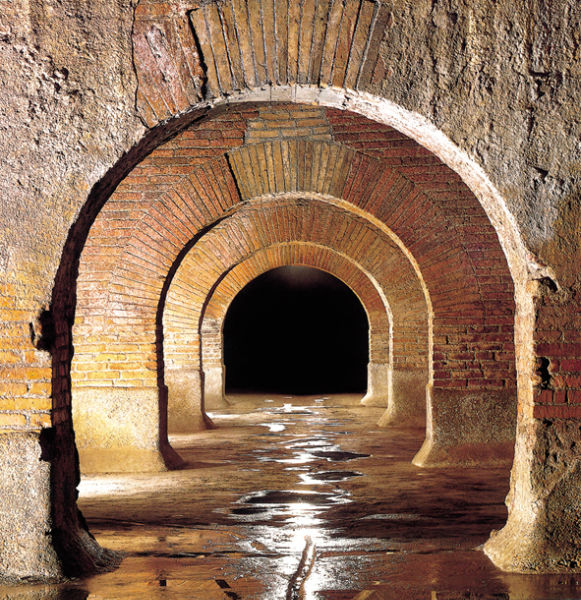 Roman Purifyng Cisterns of Fermo are one of the best testimonies of the Roman Age in Fermo. They are located under Piazza del Popolo and they are accessible through Via degli Aceti. The cisterns, probably wanted by Cesare Ottaviano Augusto, date back approximately to the first century B.C. and they are also named “Piscine Epuratorie”. The main use of the roman cisterns was to collect, store and distribute rainwater by means of a sophisticated plumbing.
Roman Purifyng Cisterns of Fermo are one of the best testimonies of the Roman Age in Fermo. They are located under Piazza del Popolo and they are accessible through Via degli Aceti. The cisterns, probably wanted by Cesare Ottaviano Augusto, date back approximately to the first century B.C. and they are also named “Piscine Epuratorie”. The main use of the roman cisterns was to collect, store and distribute rainwater by means of a sophisticated plumbing.
They are formed by 30 rooms for a total of 2200 mq which make it one of the most important monumental complex of its kind in Europe. Over the centuries, after having a deposit use, they have been in part reused as plumbing. It's not easy to imagine the medieval city of Fermo as a box of hidden evocative roman remains, perfectly preserved.
THEATRE DELL' AQUILA
.jpg)
The Theatre dell' Aquila is considered one of the most important theatre of central Italy of the eighteenth century. Carried out on Cosimo Morelli's project since 1780 it replaces the wooden theatre destroyed in a fire and located in a room of Palazzo dei Priori. Opend to the public in 1790, the theatre has always been one of the main cultural attraction for the whole Region, thanks to important shows included in the Prose and Opera season.
It holds 1000 seats, distributed in 124 boxes arranged in 5 orders. The extraordinary ceiling, decorated with a tempera painting, depicts the Gods of Olympus with Jove, Juno, the three Graces and the Six Hours Darkness aiming to listen Apollo. It's also impossible not to be impressed with the golden chandelier. The curtain, depicting Harmonia delivering zither to the fermano genius is no less important. But the stage and a perfect acoustic make it unique.
CATHEDRAL OF ST. MARIA ASSUNTA
.jpg) The Cathedral of S. Maria Assunta is one of the most important churches of Marche Region.
The Cathedral of S. Maria Assunta is one of the most important churches of Marche Region.
Located on the top of the hill, from which it's possible admire the city and a fantastic view up to the Adriatic sea and the surrounding hills, the Cathedral presents very deep roots which are still visible. It was built in an area of stratification of architectural remains dating from the Roman and Medieval period. In 1934-1935, during archaeological dig, some remains of walls of Imperial Age with bricks bearing of Antonino Pio Age and some elements of the Paleo- Christian basilica were discovered. The basilica was destroyed in 1776 by Cristiano of Magonza, diplomatic and German catholic archbishop, on orders from of Federico I Barbarossa. It was rebuilt in 1227 thanks to the work of Giorgio from Como. From reconstruction an amazing romanesque-gothic facede, a hall where there are frescoes of the fourteenth century, a funeral monument of Giovanni Visconti d'Oleggio and a tower bell are entirely visible.
oday the building is the result of a following action, wanted by Minnucci archbishop and realized by Cosimo Morelli. The new structure presents a neo-classical style. Within it, there are pieces of considerable interest such as a paleo-christan sarcophagus, a Byzantine icon and a mosaic with peacocks. Finally you can see the rose window and a rooster that is on the roof from 1423.
CASULAE OF ST. THOMAS BECKET
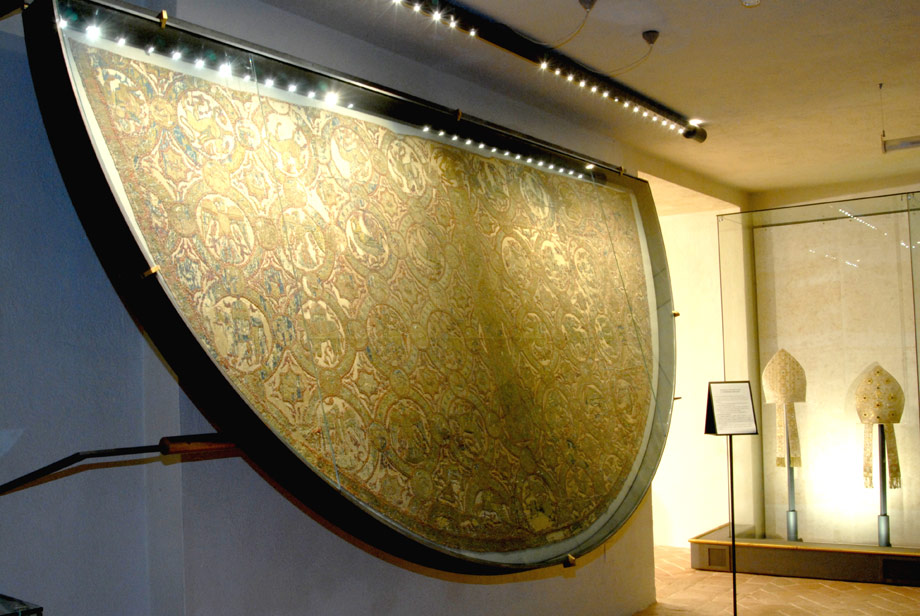
The Diocesan Museum holds the chasuble of St. Thomas Becket, murdered back in 1170. When he was officiating the holy rites in the Cathedral of Canterbury, he was crushed by four Enrico II Plantageneto King's thugs. The homicide, result of confrontation of temporale and spiritual power became the resistance's symbol of spiritual power against policy.
The matter of St. Thomas is connected to the city of Fermo thanks to the friendship between St. Thomas and Presbitero, the bishop of Fermo at the time of the omicide. St. Thomas'mother decided to give the chasuble to Presbitero, with the hope that it could be guarded with love and respect. The vestment, a blue silk tissue, embroidered in gold dates back to 1116 and it's an invaluable object. It's the most ancient arab embroidery known in the West.
TORRE DI PALME
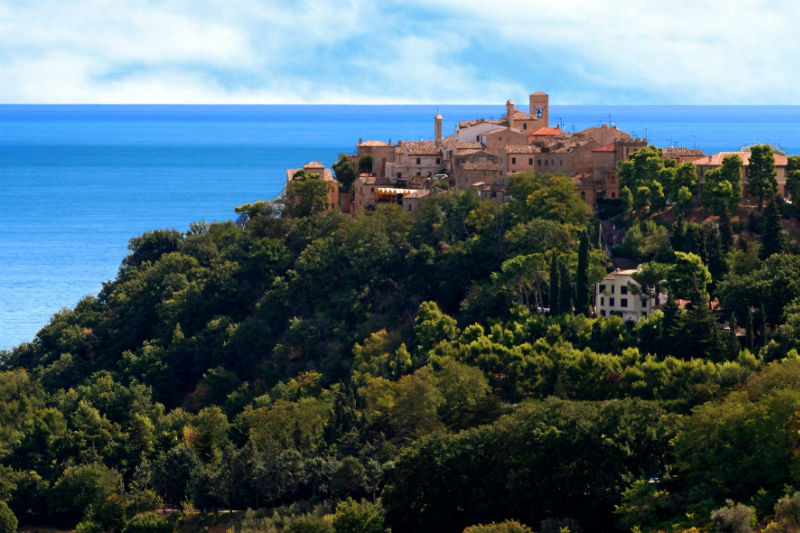 Torre di Palme is a picturesque hamlet overlooking the sea , from where a fantastic view of the Adriatic Sea can be enjoyed. The village is a real jewel so the best way to appreciate it is walking around the narrow streets that characterise it.
Torre di Palme is a picturesque hamlet overlooking the sea , from where a fantastic view of the Adriatic Sea can be enjoyed. The village is a real jewel so the best way to appreciate it is walking around the narrow streets that characterise it.
The origins of Torre di Palme are very ancient and they date back to the picena ancient city of Palma, founded in VI century b.C. and subsequently passed under the roman control. The hamlet forms part of Fermo's castles' circle, divided for their geographic position in marine castles, middle castles and mountain castles. As all marine castles, Torre di Palme rises up on a hill and shows an ellipsoidal city grid surrounded by the walls.
In the Middle Ages it was a fortified protection of the Palma's ancient port with the aim of protect it from pirates' raids. Today it's possible to admire it thanks to a perfect preservation of the whole location, which underlines the stylist uniformity of medieval and renaissance buildings. Piave street, the main street of the hamlet, allows you to cross the historic centre and appreciate amazing glimpses and the main artistic testimonies.
It's impossibile not mention the Church of St. Augustine, where is preserved a work of Vincenzo Pagani, one of the most representative artist of the Renaissance period in Marche Region, and a polyptich of Vittore Crivelli, stolen in 1972 and recovered little more than one month after in very bad conditions. Another fundamental step is St. Maria's Church which date back to XII century where it's possible notice beautiful Byzantine frescoes. Finally we found St. John's Church, the Priorale Palace and Belevedere square that leaves you breathless.
BOSCO DEL CUGNOLO
 The Bosco del Cugnolo is a rare example of Mediterranean Macchia of the Adriatic region and it can be traversed with a short, easy hike of about 2 kilometers.
The Bosco del Cugnolo is a rare example of Mediterranean Macchia of the Adriatic region and it can be traversed with a short, easy hike of about 2 kilometers.
This wooded area, surrounded by cultivated fields, takes its name from the countryside in which it is located, bordered by Fosso Cupo and Fosso Molinetto. The wood is laid down on a fossil dune, which dates back to Pleocene period, with an altitude ranging from 60 to 110 meters. From a Geological point of view, it is composed of marine sediments, in particular various types of sand. Although the evergreen forest (or “macchia primaria”) has undergone a reduction in size and environmental degradation, the integrity of the area allows it to be classified as a “relict” and included under the Region’s designation of Protected Flora Areas.
The park is characterized by a hot temperate climate in which there is scarce precipitation concentrated in the winter months, alternating with very dry summers. Tourists can admire a lot of evergreens, fruit trees and unusual varieties of vines and climbing plants that at several points make the forest intricate and impenetrable. Also the fauna is very varied. It's possible to see bees – eater, “rigogoli”, badgers and foxes.
Thanks to the history of the Grotta degli Amanti (Cave of Lovers), to walk through the wood will be very evocative.
GROTTA DEGLI AMANTI (LOVERS' CAVE)
 The Cave of lovers, located in The Bosco del Cugnolo, is the theater of the tragedy of two lovers, Antonio e Laurina, which took place in 1911, during the colonial wars for the conquest of Lybia. Returning home for a brief leave from his miltary post, Antonio in love with Laurina, decided to desert and to pass his life with her.
The Cave of lovers, located in The Bosco del Cugnolo, is the theater of the tragedy of two lovers, Antonio e Laurina, which took place in 1911, during the colonial wars for the conquest of Lybia. Returning home for a brief leave from his miltary post, Antonio in love with Laurina, decided to desert and to pass his life with her.
They were awared of the dramatic situation, thus they decided to refuge in the cave, surviving for days on bread and sardines brought to them by local fishermen. The couple felt overcome by remorse and chose to die by jumping 70 meters from the overhanging cliff of the Fosso San Filippo. The flight was to fatal to both.
THE VALLE DEL TENNA AREA
MONASTIC FRESCOES IN MONTEGIORGIO
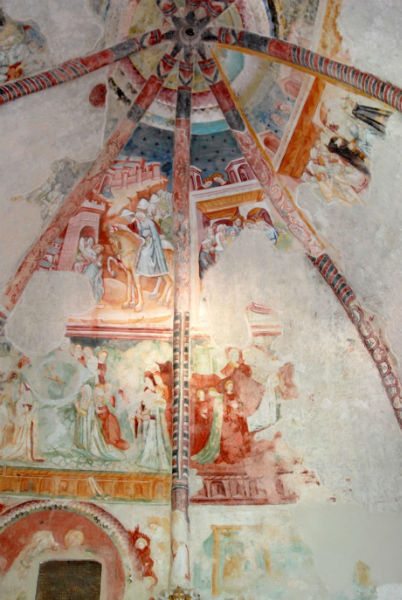 The Church San Francesco in Montegiorgio, once Santa Maria Grande in Georgio, preserves wonderful frescoes.
The Church San Francesco in Montegiorgio, once Santa Maria Grande in Georgio, preserves wonderful frescoes.
The Church, in a perfect roman-gothic style, dating back to the XIII century, with its monastery belonged to ferfensi monks and it was transferred in 1263 to friars of St. Francis monastery. With the Pontificate of Sisto V, the church suffered considerable changes, but it's possible admire the magnificent door in travertine of 1325 yet.
The famous Farfense Chapel preserves painting of the first half of the XV century showing the Legend of the Holy Cross, hypothetically attributed to Antonio Alberti da Ferrara, while other paintings showing the scenes of the Death, the Assumption of Mary and St. Francis who receives the stigmata are probably works of an other artist. Frescoes show an active participation of characters represented with colorful typical costumes. In the Chapel graves of Patti, Calisti, Zenobi and Alaleona's families are still preserved.
MONASTIC FRESCOES IN SANTA VITTORIA IN MATENANO
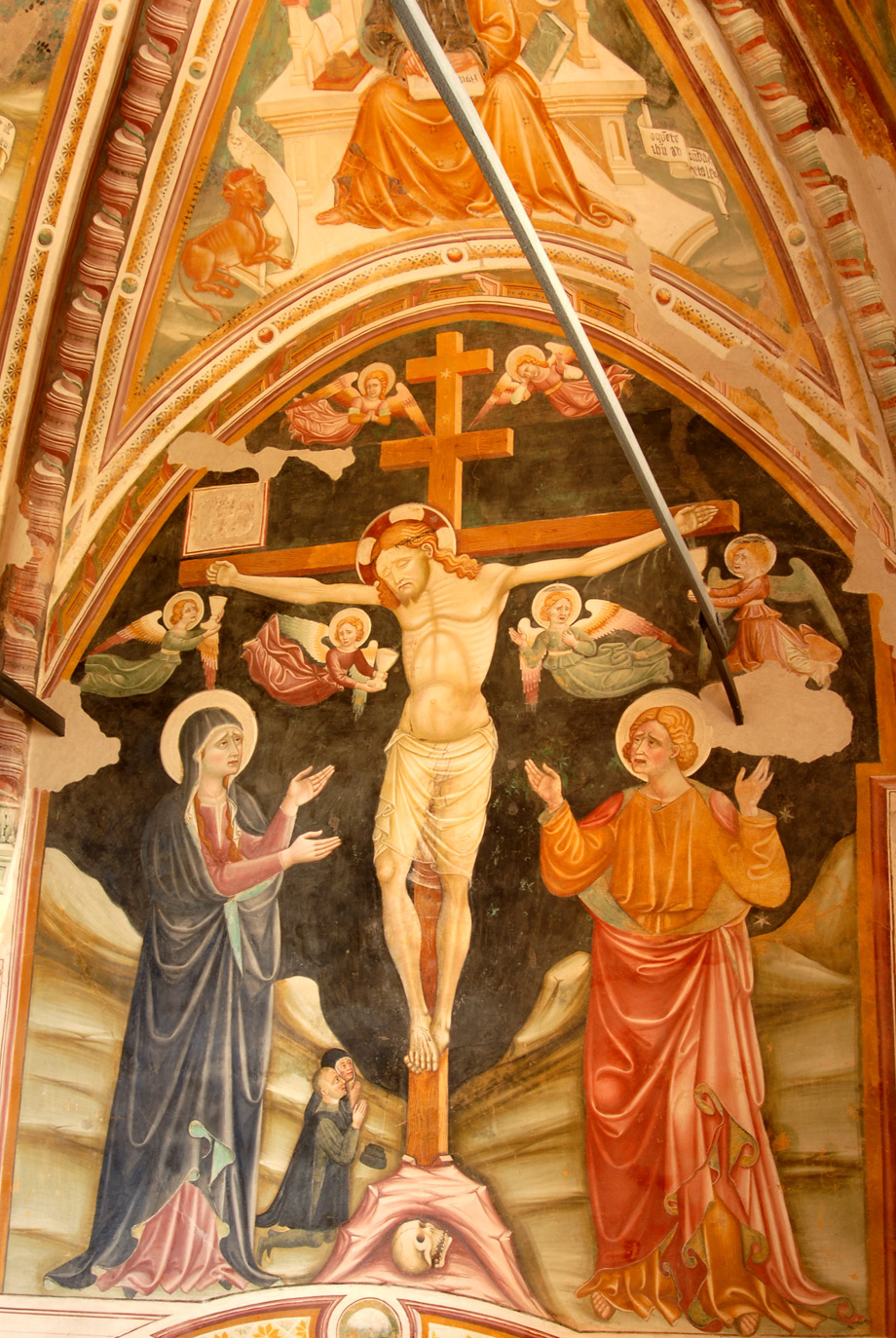 Santa Vittoria in Matenano is a little village in the Province of Fermo, founded by the Monks of the Abbey of Farfa.
Santa Vittoria in Matenano is a little village in the Province of Fermo, founded by the Monks of the Abbey of Farfa.
Not to be missed is the Church of the Resurrezione that preserves beautiful monastic frescoes. The name comes from the Resurrection of Christ, represented on the major altar, but also from the basement with an ossuary. Despite the Church is named Chiesa della Resurrezione, people continue to name it “Cappellone” for the amazing baroque paintings relised by Malpiedi di S. Ginesio discovered in a part of the ancient monastic church. It's also possible appreciate paintings about Eucharistic scenes of Francesco Braschi.
Inside the Church we can admire the Cappella degli Innocenti, also named Oratorio Farfense, a fantastic example of monastic art. In the walls the painter Giacomo da Campli with the help of Frà Marino Angeli realised frescoes of the histories of the Gospel. The existence of the Chapel allowed to rebuild the ancient Church of the monastery , built in the X century. The preservation of this little part is due to Mrs Maria Vittoria Perfetti who, after the demolition in 1771, wanted important artistic testimonies were cared. Inside the Church there is also a sandstone with the embassement of the year M.CCC.CXVIII in semigothic letterings.
THE MOUNTAIN AREA
ABBEY OF SS. RUFFINO E VITALE IN AMANDOLA
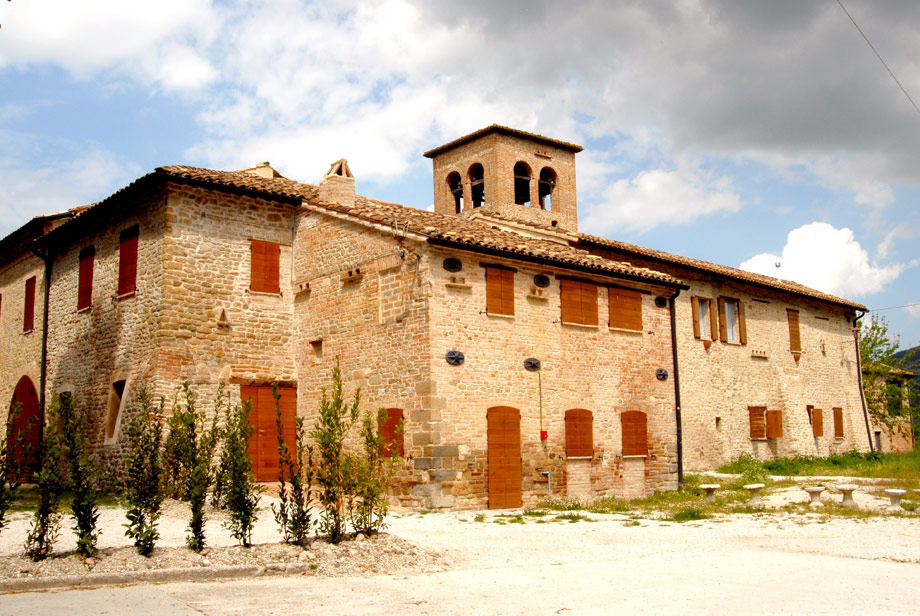 The Abbey of SS. Ruffino and Vitale is located a few kilometers from the historic centre of the medieval village of Amandola.
The Abbey of SS. Ruffino and Vitale is located a few kilometers from the historic centre of the medieval village of Amandola.
The Church, in a perfect Romanesque style, despite the numerous renovations, dates back to the second half of the XI century. The south side of the Abbey shows the monastery with its courtyard; the tower, raised up only in the XIII century to be subsequently transformed in a bell tower, connects the monastery with the religious building.
The inside of the church is instead characterised by three naves, divided in pillars. The presbytery, decorated with frescoes of the XIV-XV century is raised up on a crypt, dating back to the VI century.
The Crypt is divided in five aisles, with columns decorated with valuable capitals and it preserves the spoils of the Saint. The history says about a young boy, probably a farmer, who decided to plow several hectares of land for the benefit of others farmers. Because of that, under the spoils of St. Ruffino, there is a hole that can be crossed hands and knees by people suffering of hernia problems for three times.
Every year, on the 19th of August it's usually celebrate the most ancient religious holiday of Sibillini Mountains: the Fair of SS. Ruffino and Vitale. Visitors can enjoy of enogastronomic products, craft products and folkloristic dances and music. Fair's origins seems to stem from a battle between Montefortino municipality and Monte San Martino municipality back in 1306.
MONTEFORTINO
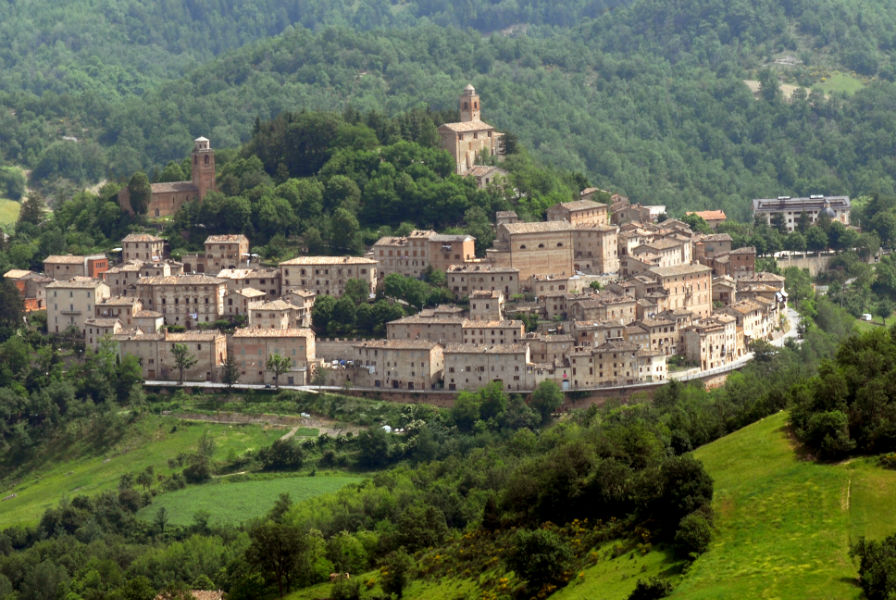 Montefortino rises up on top of a slope of the Sibillini Mountains. Historical evidence be traced back first settlements to the period of Augusto's Empire; the Roman “centuriazione” which shapes the whole area is visible yet and it was destinated to Roman soldiers like residence of end of career.
Montefortino rises up on top of a slope of the Sibillini Mountains. Historical evidence be traced back first settlements to the period of Augusto's Empire; the Roman “centuriazione” which shapes the whole area is visible yet and it was destinated to Roman soldiers like residence of end of career.
On the contrary, the historic centre shows in its entirity an allignment of streets and houses along concentric semicircles, in accordance with a characteristic medieval plan, that it's possible to find in many others villages of the Umbro-Marchigiano Appennines. The fortified village was built in the XII century and became a free municipality in 1084. After being a possession of Fermo, Montefortino kept under Camerino during the first half of 1400 and then under the Sforza Lordship. In 1586 it was incorporated in the garrison of Montalto of Papal States and in 1860 it voted for the transition from Fermo's dioces of Papal States to the Kingdom of Italy.
Some important attractions that tourist can't lost are the Church of Madonna del Fonte, the door of St. Lucia by which it's possible to enter to the old town, St. Francesco's Church and St. Agostino's Church. Moreover tourists can admire the Pieve of St. Michele Arcangelo, Leopardi palace, seat of the Civic Art Gallery "Fortunato Duranti", the temple of clock, the Palace of municipality and St. Andrea's Church.
INFERNACCIO'S CLEFT
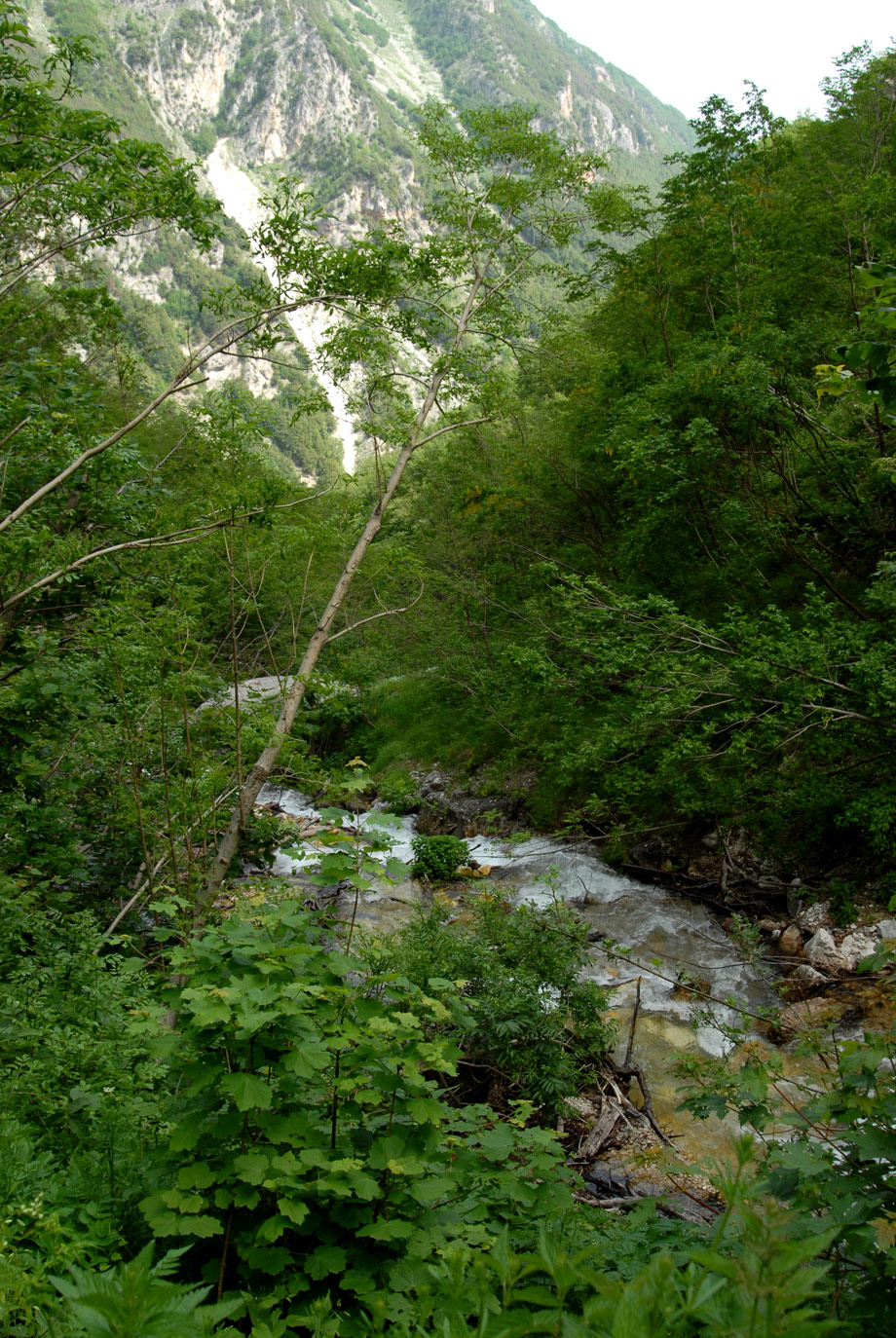 Infernaccio's clefts are natural clefts created thanks to the erosive effect of Tenna river and they are located in Montefortino, in Province of Fermo. They are one of the most evocative natural attractions of the Sibillini Mountains.
Infernaccio's clefts are natural clefts created thanks to the erosive effect of Tenna river and they are located in Montefortino, in Province of Fermo. They are one of the most evocative natural attractions of the Sibillini Mountains.
Every year they are the ideal destination for tourists and local people, whose take advantage of spring and summer season to take walks and excursions in an amazing environment. In particular there are three routes that can be undertaken.
It's possible easily reach the “Cascata Nascosta”, the source of Tenna river and the St. Leonardo's hermitage. The story of St. Leonardo's hermitage, reachable only by foot, helps to make unique this location. The hermitage was subject of renovation from 1970 to 2014 from Pietro Lavini, an hermit priest, died in 2015.
About infernaccio's clefts, that once connected two opposite valleys, the tradition says a curious story: the street which leads to clefts and once reached by Fairies of Sibyl to dance with shepherds, was named “Valleria” to indicate dances, “valli” in dialect. But one night, they were excited and emotioned, so they violeted the obligation to get back to the cave before sunrise. When they realized it, they took to run leaving behind a light wake. Today it's possible admire it on the back of the mountain and it's called the “Way of Fairies”.
SANCTUARY OF THE MADONNA DELL'AMBRO
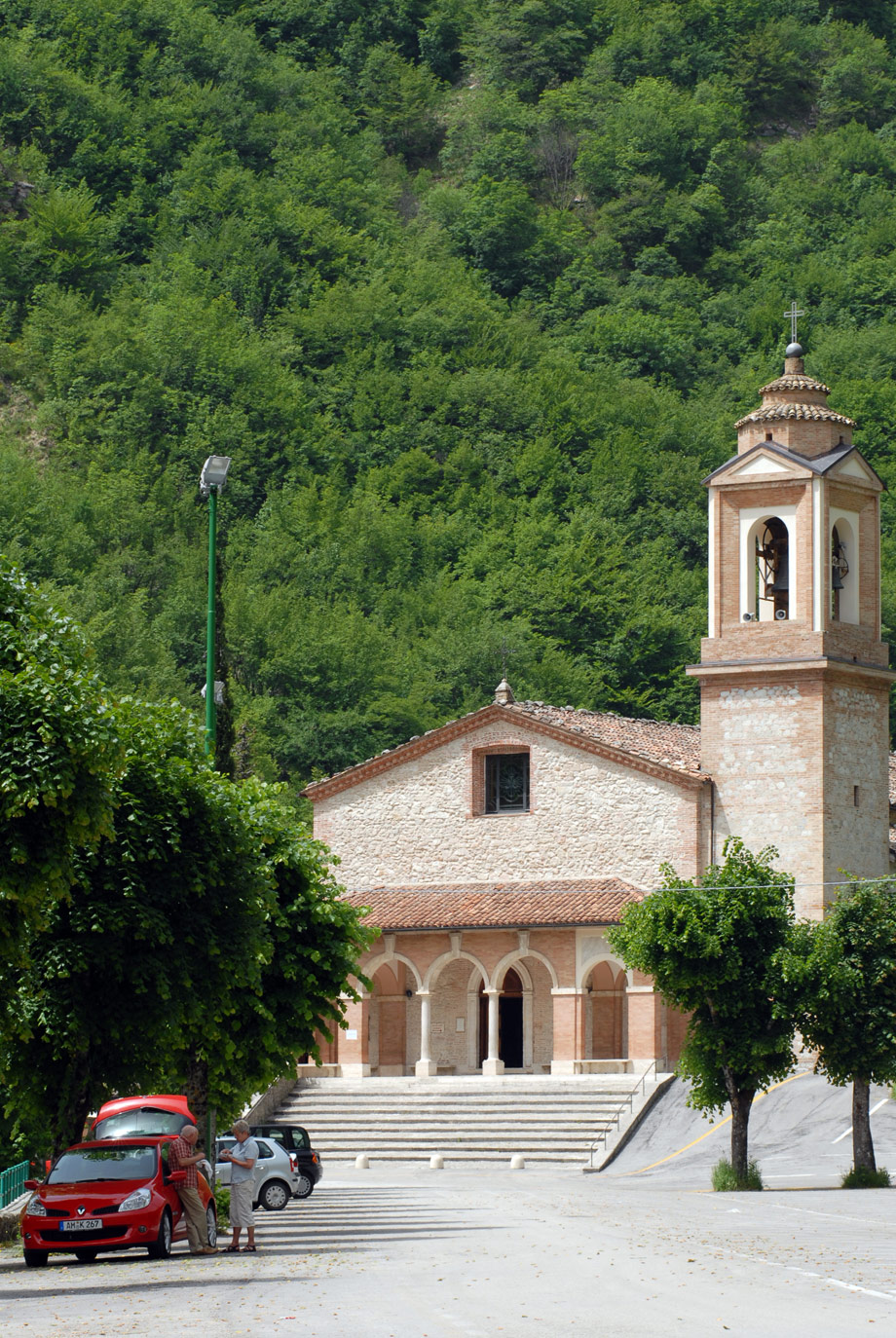 The shrine of Madonna dell' Ambro is located in Montefortino and named from the Ambro river, which flows next to it.
The shrine of Madonna dell' Ambro is located in Montefortino and named from the Ambro river, which flows next to it.
The little monastery, the porch and the tower bell trace to the XX century, but tradition says that the Chapel was erected after a miraculous event: the Virgen appeared to Santina, a humble shepherdess of Montefortino, mute from the birth and gave her the gift of speech. The Church, as we can see it today, was rebuilt in 1603 after Montefortino went tearing down a little house near the ancient church, to start the construction of the Chapel.
In 1602, the traslation from the ancient Church to the new “residence” of the Madonna dell' Ambro's sacred picture, magnificent figure carved in stone was made. The construction of the new building continued for over 30 years, and in the meantime works of painters and sculptors decorated the Chapel. The sanctuary is also named the Little Lourdes of Sibillin Mountains thanks to the similarity with the most famous sancturay of France, both for the evocative territory where the shrine is located, and for the story of the Maddonna's appearance.
THE SHOE DISTRICT
TOD'S OUTLET AND CASTAGNO BRAND VILLAGE
The fermano territory is characterised by small and medium businesses engaged in the realisation of craft products. Most of them are involved in the footwear sector and the manufacture of hats. A lot of products, realised in this rich land are real brands, famous all over the world. Thanks to the shoe district, the Province of Fermo can be considered a shopping's paradise. Some examples can be the “Il Castagno” brand village and the Tod's Outlet.
In the “Il Castagno”, you can find prestigious italian fashion outlet stores. In its spaces it's possible to find hand made accessories and shoes by the best artisans of the most famous shoe district.
In the Tod's Outlet there are different brands of Tod's team that, in the midst of their identity, they have in common a filosophy of tradition, modernity and high quality. The beauty of tradition is to have a hand made product with high artisan techniques that make unique every product.
THE PROVINCE OF ANCONA
LORETO
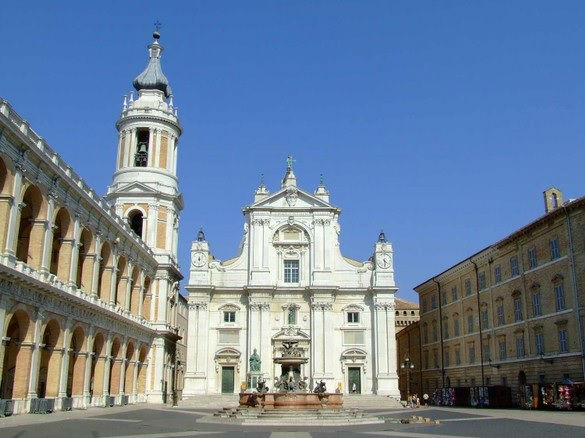 Loreto is an important city of art, culture and faith of the Marche Region.
Loreto is an important city of art, culture and faith of the Marche Region.
The history of the city doesn't seem to have very ancient origins. In a list of churches drawn up in 1249 nobody talked about Loreto. Actually, the history of this evocative city goes back to the night between the 9th and 10th of December 1294. After the final expulsion of crusaders from the muslim people from Palestine in 1291, it was decided to save the history of Christ, Mary and the Apostles. The legend says angels moved to Loreto the Santa Casa. Really, there are a lot of theories try to refute this story, including a wedding certificate between Filippo, son of Carlo d'Angiò, king of Naples and Margherita, daughter of Niceforo Angeli, despot of Epiro and descendant of emperors of Constantinople, where Niceforo Angeli gives to Filippo the holy stones of Santa Casa and a painting of the Virgin with baby Jesus. From Niceforo's surname would result the mistake. Anyway stones wouldn't be there only for human coincidence.From 1300 there are testimonies of first real pilgrimages to Loreto, that from then on becames with others sanctuaries one of the main destinations for Christians.
The construction of the renaissance Basilica's complex started in 1468 thanks to Nicolò de Astis, bishop of Recanati. Under the cupola, there is the Santa Casa and inside of it the famous statue of Madonna Nera. The entire design of the Basilica is a work of unique mastery but the marble coating of the Santa Casa seems the most amazing part of the sanctuary. It took 70 years to complete it and it eas considered the more difficult artistic expression of the sculpture of 1500. The paintings of the cupola are the greatest work of religious art between 1800 and 1900. Loreto is also rich in beauties like the Apostolic Palace, the Bastion of St. Gallo, the Acquedotto degli Archi, the Fontana Maggiore di Piazza della Madonna, the Civic Art Gallery and the walls.
THE PROVINCE OF MACERATA
LEOPARDI'S HOME
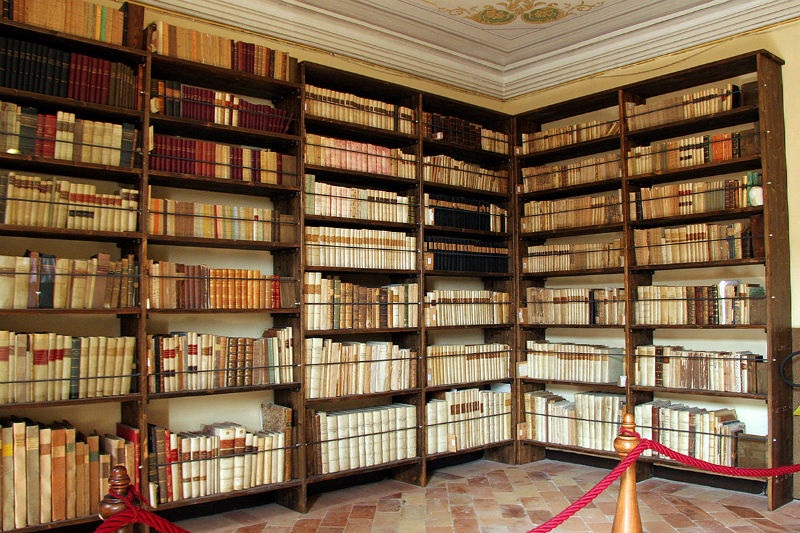 Leopardi's Palace is an important palace of Recanati, known for being the childhood home of the famous Poet Giacomo Leopardi, who was born from the marriage between the Monaldo Leopardi Count and Adelaide of Antici Marquis on the 29th of June in 1798.
Leopardi's Palace is an important palace of Recanati, known for being the childhood home of the famous Poet Giacomo Leopardi, who was born from the marriage between the Monaldo Leopardi Count and Adelaide of Antici Marquis on the 29th of June in 1798.
The palace dates back to the XVIII century when Carlo Orazio Leopardi, great uncle of the Poet and important architect at that time, decided to bring together in a single structure different buildings where Leopardi's family lived since the XIII century.
Visitors will have the possibility to visit the first floor of the Palace, where there is the well-known Library which contains 20.000 volumes, patiently collected by Monaldo Count. It's a real heritage of books. The initial idea was to achieve a real place of learning for his children, where in fact Giacomo and his brothers Carlo and Paolino spent their youth. Then the library expanded so much that Monaldo decided to open it to friends but also to citizens of Recanati.
The upper floors sapiently frescoed and furnished with furniture dating back to the XVI and the XIX century are still inhabited by descendants of Leopardi's family. In the basement there is a former mill, since 1995 used a seat for organisation of Poet's exhibitions. Near to mill, it's possible to admire the ancient wineries of the palace, built in 1600-1700, which are an evidence of the secolar oenological tradition of the city. Some documents attest the wine production by the family already from the XIV century. Today wineries are used to host meetings, conferences and enogastronomic or cultural events. The palace is surrounded by gardens and buildings, seat of the World Centre of Poetry.


Student Competition
Social Links & Tools
The official hashtags for the Student Competition will be #iscfermo, #mediterraneandiet and #destinazionemarche.
We strongly encourage students, lecturers, and all people involved in the Student Competition to post in multiple social networks using these hashtags.





